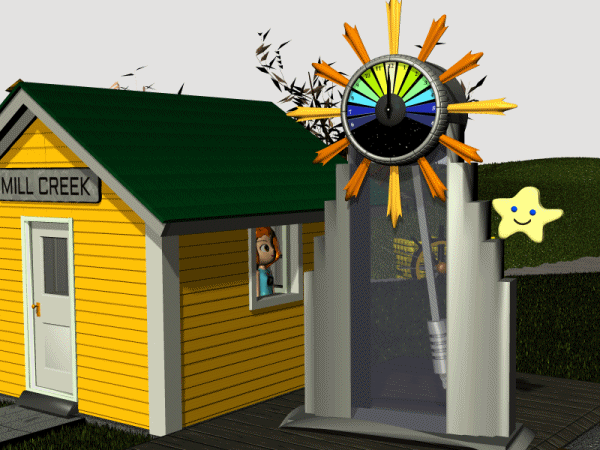Sunday, April 26, 2020
Fan clocks
Fan clocks might be nothing more than an idea, or might have really existed. The evidence for existence is scanty. As with the magnificent Ridhwan clock, the only documentation is a couple of crude sketches and a clear description.
 The clock on the left was supposedly mounted in a piece of church furniture called an ostensoir. The larger sketch above was an attempt to reconstruct a similar clock in the 1890s, described clearly in SciAm.
The ostensoir above looks obscene in several ways, so I decided not to copy it. Most ostensoirs look more Decoish, so I went with Deco, making a building-size clock.
With the Ridhwan, I was bowled over by its structured Islamic beauty, and tried to do it justice with my reconstruction.
This fan clock didn't bowl me over, but it nicely demonstrates how an Equation Clock worked. Equation Clocks served to bridge the gap or Equation between Sidereal and Local or Personal Time.
The fan blades represent Sun Time, narrowing down in winter and widening out in summer. The hands rotate at constant speed like any clock, and you can read the Sidereal or standard time by the notches on the outer case. When the hands pass over the Sun Time blades, you can see the time referenced to the span of sunrise to sunset.
The clock on the left was supposedly mounted in a piece of church furniture called an ostensoir. The larger sketch above was an attempt to reconstruct a similar clock in the 1890s, described clearly in SciAm.
The ostensoir above looks obscene in several ways, so I decided not to copy it. Most ostensoirs look more Decoish, so I went with Deco, making a building-size clock.
With the Ridhwan, I was bowled over by its structured Islamic beauty, and tried to do it justice with my reconstruction.
This fan clock didn't bowl me over, but it nicely demonstrates how an Equation Clock worked. Equation Clocks served to bridge the gap or Equation between Sidereal and Local or Personal Time.
The fan blades represent Sun Time, narrowing down in winter and widening out in summer. The hands rotate at constant speed like any clock, and you can read the Sidereal or standard time by the notches on the outer case. When the hands pass over the Sun Time blades, you can see the time referenced to the span of sunrise to sunset.
 Here's a fast animation through the seasons, showing the fan contracting from summer through equinox to winter.
Here's a fast animation through the seasons, showing the fan contracting from summer through equinox to winter.
 = = = = =
Links for the Ancestral Clocks set so far:
The magnificent Ridhwan.
Clock dance.
Crude water clock.
Observatories
The Elgin observatory.
The Riefler clock.
Personal Equation Machines.
More Elgin ads.
Fan clocks.
= = = = =
Links for the Ancestral Clocks set so far:
The magnificent Ridhwan.
Clock dance.
Crude water clock.
Observatories
The Elgin observatory.
The Riefler clock.
Personal Equation Machines.
More Elgin ads.
Fan clocks.
 The clock on the left was supposedly mounted in a piece of church furniture called an ostensoir. The larger sketch above was an attempt to reconstruct a similar clock in the 1890s, described clearly in SciAm.
The ostensoir above looks obscene in several ways, so I decided not to copy it. Most ostensoirs look more Decoish, so I went with Deco, making a building-size clock.
With the Ridhwan, I was bowled over by its structured Islamic beauty, and tried to do it justice with my reconstruction.
This fan clock didn't bowl me over, but it nicely demonstrates how an Equation Clock worked. Equation Clocks served to bridge the gap or Equation between Sidereal and Local or Personal Time.
The fan blades represent Sun Time, narrowing down in winter and widening out in summer. The hands rotate at constant speed like any clock, and you can read the Sidereal or standard time by the notches on the outer case. When the hands pass over the Sun Time blades, you can see the time referenced to the span of sunrise to sunset.
The clock on the left was supposedly mounted in a piece of church furniture called an ostensoir. The larger sketch above was an attempt to reconstruct a similar clock in the 1890s, described clearly in SciAm.
The ostensoir above looks obscene in several ways, so I decided not to copy it. Most ostensoirs look more Decoish, so I went with Deco, making a building-size clock.
With the Ridhwan, I was bowled over by its structured Islamic beauty, and tried to do it justice with my reconstruction.
This fan clock didn't bowl me over, but it nicely demonstrates how an Equation Clock worked. Equation Clocks served to bridge the gap or Equation between Sidereal and Local or Personal Time.
The fan blades represent Sun Time, narrowing down in winter and widening out in summer. The hands rotate at constant speed like any clock, and you can read the Sidereal or standard time by the notches on the outer case. When the hands pass over the Sun Time blades, you can see the time referenced to the span of sunrise to sunset.
 Here's a fast animation through the seasons, showing the fan contracting from summer through equinox to winter.
Here's a fast animation through the seasons, showing the fan contracting from summer through equinox to winter.
 = = = = =
Links for the Ancestral Clocks set so far:
The magnificent Ridhwan.
Clock dance.
Crude water clock.
Observatories
The Elgin observatory.
The Riefler clock.
Personal Equation Machines.
More Elgin ads.
Fan clocks.
= = = = =
Links for the Ancestral Clocks set so far:
The magnificent Ridhwan.
Clock dance.
Crude water clock.
Observatories
The Elgin observatory.
The Riefler clock.
Personal Equation Machines.
More Elgin ads.
Fan clocks.
